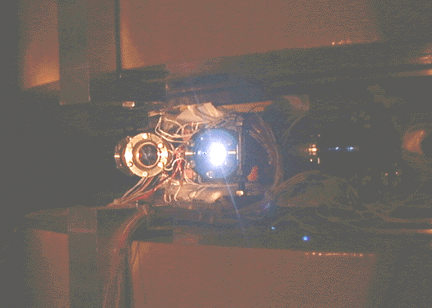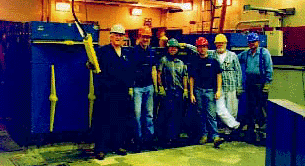SURF III Upgrade
First Light from SURF III

Synchrotron radiation was observed from SURF III for the
first time at 11:10 on the morning of 17 Dec 98, just 3 days
after the commissioning process began. This photograph shows the first stored
beam - 100 MeV electrons and an unknown (probably on the order of a
few mA) stored current.
Current Status
The first stored beam and production of synchrotron radiation from
SURF occurred at 11:10 AM 17 Dec 98. The initial
electron beam was an unknown current (probably on the order of a few mA)
of 100 MeV electrons. Later in the day that beam was ramped up to
380 MeV. The commissioning process will continue and the maximum
energy, beam current, and beam lifetime will be improved.
The web page describing SURF II
and the science experiments being conducted is still available.
 See the construction of the SURF magnet.
See the construction of the SURF magnet.
 See the assembly of the SURF lower yoke.
See the assembly of the SURF lower yoke.
 Take a pictorial tour of the disassembly of SURF II.
Take a pictorial tour of the disassembly of SURF II.
Project Overview
The Electron and Optical Physics Division
of the Physical Measurement Laboratory has
operated the Synchrotron Ultraviolet Radiation Facilty at the National
Institute of Standards and Technology (NIST)
for over 30 years. Initially operated in a parasitic mode at the NIST electron
synchrotron, the facility was converted into the SURF II electron storage ring in
1974. SURF II has been the United States national standard of irradiance in
the vacuum ultraviolet spectral region as well as a world-class research facility
for many diverse fields of investigation that require high-intensity continuum
radiation from the soft x-ray to the infrared spectral regions.
The radiometric accuracy of SURF II as an irradiance standard was limited
by the uniformity of the magnetic field encountered by the electrons as they
traversed their orbit. Variations of up to 0.5% limited the knowledge of the
local bending radius at any tangent point and restricted the accuracy of the
irradiance calculations. Additionally, the performance of the magnet structure
is no longer state-of-the-art. Modern magnetic materials have better performance
characteristics than materials available in the 1940's, when the electron
synchrotron magnet used by SURF II was built, and the conversion of SURF
from a 60 Hz AC synchrotron to a DC storage ring changed the desired
characteristics of the magnet material and the shape of the poles so that the
original design choices are no longer the most appropriate.
Two improve the radiometric accuracy of SURF, an entirely new magnetic structure
was designed and is being built. The general contractor for the project is
PSL
Engineering and Instrumentation. The azimuthal uniformity of the SURF
magnetic field will be improved by a factor of 50, allowing irradiance calculations
to be made with much higher accuracy than SURF II could achieve. As an
additional benefit, the use of improved magnet material, a smaller air gap between
the poles, and a higher electrical current (new magnet windings will be installed)
will increase the magnetic field strength at the electron orbit, allowing SURF
to store electrons at energies as high as 400 MeV, compared to 300 MeV
for SURF II. The higher electron energy will extend the usable range of
radiation from SURF to shorter wavelengths, enabling experiments in the
"water window" from 2.3 nm to 4.4 nm.
Improvements
The primary purpose of the upgrade from SURF II to SURF is to
improve the radiometric accuracy of SURF as an irradiance standard by improving
the magnetic field uniformity. The upgrade project offers an excellent opportunity
to make other improvements and modifications to the facility. The following list
outlines the major changes being made and the improvements they offer.
- New yokes and backlegs for magnet
- The new magnet structure consists of several solid pieces of iron designed
for the DC operation of a storage ring. The previous magnet consisted of
thousands of layers of very thin iron laminations pressed together - a design
appropriate for the old synchrotron which operated in a 60 Hz AC mode.
The solid pieces of iron will support higher magnetic fluxes than the laminated
structures.
- New poles for the magnet
- The new poles are designed to create a magnetic field with a three-dimensional
structure appropriate for a storage ring. The previous pole pieces were designed
for a betatron, requiring that the magnetic field be corrected by "trim coils"
when converted to a storage ring. Additionally, the air gap between the upper
and lower poles will be smaller in SURF, providing increased magnetic field
strength at the electron orbit.
SURF is designed so that there is no need for trim coils to correct the
magnetic field structure at the principal energies to be used for radiometry. Two
trim coils are being installed, however, to allow some tunability in the magnetic
field to correct for possible eddy current effects during the ramp from injection
energy (10 MeV) to the final operating energy and to allow stable operation
at a wide selection of electron energies.
SURF III's magnetic field will be:
- more uniform (improves radiometric accuracy)
- stronger (allows higher electron energies)
- the correct structure for a storage ring
- New electrical windings for magnet
- The SURF II magnetic coils are over twenty years old and have become
unreliable due to their age. The new coils will be designed to carry higher
electrical currents - on the order of 850 A instead of the 700 A
carried in SURF II, and the induction will be increased from 182 kA t
(kiloampere turns) to 204 kA t. This higher induction will further
increase the magnetic field strength, allowing higher stored electron energies.
- Improved coooling system
- SURF III will operate with higher electrical currents in the magnet
windings, and will dissipated somewhat more power in the magnet structure. An
improved cooling system is being installed to handle the additional heat load.
- Two new beamlines
- Two new photon beam ports are being installed in the vacuum chamber between
the existing beamline 6 and beamline 7 ports. The new beamlines
(BL-6a and BL-6b) will provide additional experimental capacity for a UV/Visible
radiometry program and will allow the extension of SURF III as an irradiance
standard into the visible and infrared spectral regions as well.
- Two high acceptance beamlines
- Two of the existing beamlines will be modified to accept over 80 mrad in
both the horizontal and vertical directions, an increase of almost 25% over the
present configuration. These high angular acceptance beamlines will provide users
with high photon fluxes, particularly in the infrared spectral region where the
intrinsic divergence of synchrotron radiation is high.
- New accelerator control system
- A modern control system with a graphical user interface and running on a
desktop computer will be installed. This system will replace the present analog
control system, which dates from 1974.
- Possible: New RF accelerating cavity
- The increase in stored electron energy in SURF III will require a higher
RF voltage in the accelerating cavity. This voltage is near the design
limitation of the existing cavity. If the cavity shows indications of breaking
down at the high voltages required, a new RF cavity will be designed and installed.

NIST staff involved in the upgrade (left to right): Bob Madden, Mitch Furst,
Lanny Hughey, Rob Vest, Andrew Hamilton, and Rossie Graves. Not shown is
Al Raptakes (who's taking the picture). The crew is standing in front of the
partially disassembled SURF II storage ring - only the backlegs and lower yoke
iron remain.
Inquiries or comments: Rob Vest, SURF III, NIST
Privacy Statement / Security Notice
- NIST Disclaimer

  Online: November 1994
- Last Updated: December 1998
Online: November 1994
- Last Updated: December 1998
|





 Online: November 1994
- Last Updated: December 1998
Online: November 1994
- Last Updated: December 1998